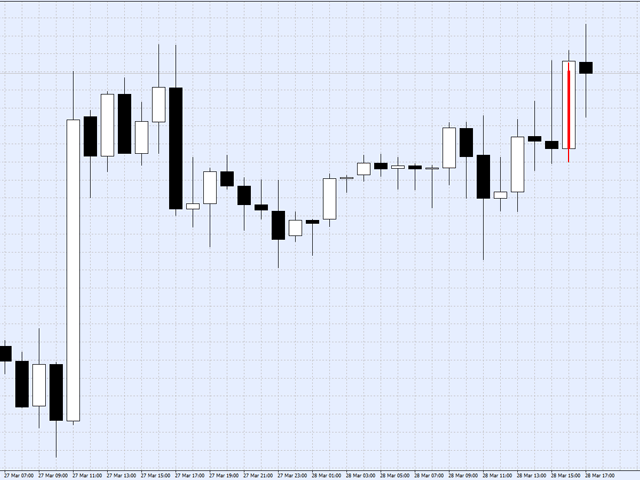The indicator is unique in its kind. It predicts the bars that may appear in the future using the theory
the cyclical nature of price movements and a certain degree of stationarity in the market.
With this indicator, you can predict both 1 bar in the future and a lot of bars in the future.,
thus, making up a potentially possible picture of the development of events in the
market.
This indicator is
based on 5 forecasting methods. The first method is the Fourier transform. The rest are linear forecasting methods in various variations. You can
you can choose which method to use. The analysis is based on historical data, and the more data is
accepted for analysis, the more accurate the forecast is. The Fourier method has the greatest
accuracy, but requires a lot of computing resources, so sometimes apply
its not advisable.
If you are setting a large amount of data for
analysis (>1000), then it is advisable to apply linear forecasting methods,
which work much faster. The peculiarity of this indicator is
that the input of forecasting methods is not the price, but the average price
increments. That is, the calculation of one close is based on the values of open, high, low and the previous values of high, low. The same applies to the
other values of the bar.
[spoiler title=”Read More…”]
The indicator has the ability to predict not only
the future value of the price, but also move the starting point of the forecast by N bars to
the past, so that you can choose the best ones for the current moment
parameters. With this indicator, you will have the opportunity to look into the future and find
out possible scenarios for the current
relationship between past and current prices. Naturally, in the market
there are also many other processes. Perhaps they are to some extent
they are chaotic, so, when combined with cyclical processes, they distort the real picture
regarding the forecast. But there are times when cyclical processes dominate and the
forecast is absolutely accurate, and there are times when other processes dominate and the
forecast becomes less accurate.
Thus, you can use the
indicator both for its intended purpose-the forecast of movement, and to determine
what processes in the market now dominate in terms of the degree of similarity
the predicted movement with the real one. By installing this indicator, you will be surprised
how predictable the market is sometimes.
- Method-forecasting method (1 – using the Fourier transform, 2,3,4,5-linear forecasting methods).
- LastBar – the number of the bar from which to start the forecast (0 – from the current one, any other number, the number of bars in the past).
- PastBars – the number of bars used for analysis (for the Fourier method, it is recommended from 100 to 1000, more slows down calculations, for other methods, you can set more than 10000, but you will have to wait a long time).
- LPOrder-prediction accuracy from 0 to 1 (used only for linear forecasting methods).
- FutBars – the number of bars that will be predicted (should not be more than PastBars, but better 2-3 times less).
- HarmNo – the maximum number of frequencies for the Fourier method (it is recommended to set 1/2 or 1/3 of the PastBars, it greatly affects the speed of calculations, the larger the number, the slower it counts. There shouldn’t be more than
PastBars
). - FreqTOL-prediction accuracy for the Fourier method (the higher the accuracy, the slower it counts. Recommended no more than 0.00000001).
- FreqMax – the maximum number of iterations for frequency reduction (you can not change it).
- BurgWin – function for weighted averaging (for linear forecasting methods; 0 = no weighted averaging, 1 = Hamming method, 2 = parabolic method).
- P is the period of averaging increments (for H1, 12 is recommended, for M30 =24, M15 =48, for M5 =60, you can put 1, the results are also good, you can experiment).
- TF-the timeframe on which the indicator is installed (specified in minutes, for H1 set =60).
- s1=”High=(Hoh Hhl H3)/3″ – data for calculating the High value, (at least 1 must be included).
- Hoh_= true.
- Hhl_=true.
- H3_=true.
- s2= “Low=(Lol Lhl L3)/3” – data for calculating the Low value, (at least 1 must be included).
- Lol_=true.
- Lhl_=true.
- L3_=true.
- s3= “Close=(Coc Chc Clc)/3” – data for calculating the Close value, (at least 1 must be included).
- Coc_=true.
- Chc_=true.
- Clc_ =true.
Calculations can take from tenths of a second to several minutes, or even tens of minutes or even days, depending on the established depth of history for analysis. If the terminal has stopped responding, it means that the calculation is underway and you need to wait. The indicator never “hangs” the terminal, eventually it will finish the calculation. Do not set more than 3000 analysis bars for the Fourier transform (for other methods, more than 20000), as this will greatly slow down the work, or if you want a greater depth of analysis, set a large TF value, for example, 240, otherwise, the calculation will never be finished, since the forecast is recalculated on each new bar.
[/spoiler]





